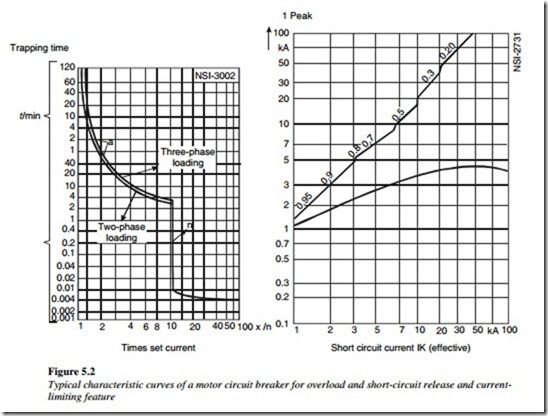High-voltage circuit breakers
High-voltage circuit breakers are either of the oil type, in which the contacts open under oil, or of the air-blast type. In this type of breakers, high-pressure air is forced on the arc through a nozzle at the instant of contact separation. The portion of ionized air between the contacts is blown away by the blast of high-pressure air. Therefore, they are called either air-blast circuit breaker or compressed air-circuit breaker.
A CT, on an inverse-time relay in which the time of closing the relay contacts is an inverse-time function of the current, initiates tripping of the high-voltage circuit breaker.
Therefore, the greater the current, the shorter is the time of closing.
When the DC circuit is closed by a relay contact, a DC tripping coil trips the breaker. The circuit breakers should open the circuit within 6 cycles from the time of closing of the relay contacts. Air-blast circuit breakers have received a wide acceptance in all fields for both indoor and outdoor applications. Indoor breakers are available up to 40 kV and interrupting capacities of up to 2.5 GVA. Outdoor three-pole breakers are available in extra-high-voltage ratings of up to 765 kV, capable of interrupting 55 GVA or 40 000 A of symmetrical current.
Motor circuit breakers
Motor circuit breakers provide overload, short-circuit, and single-phase protection for three-phase motors. The motor circuit breaker has a toggle switch for ease of operation and has auxiliary contacts, trip indicating contacts, and a U/V or shunt release.
The three-pole circuit breaker can be connected in parallel to the fuses. In the event of one fuse blowing, the breaker actuated through its release gives a tripping signal through
its auxiliary contacts to the motor control device to switch off the motor. Thus, the motor is not subjected to single phasing, and costly motor burnouts are prevented.
The motor circuit breakers operate on the current-limiting principle. In the case of a short-circuit, the contacts are opened electro-dynamically by the short-circuit current. The instantaneous over-current releases, through the switching mechanism trips all the three poles of the breaker. A large arc voltage is quickly built up in the arc chamber, limiting
the short-circuit. The breakers have a trip-free mechanism, and tripping cannot be prevented by the toggle switch position. After clearing the fault that caused the short-circuit, the limiter must be reset by hand before the circuit breaker can be switched on again.
Typical characteristic curves for overload and short-circuit release, and the current- limiting feature of a motor circuit breaker are shown in the Figure 5.2.
